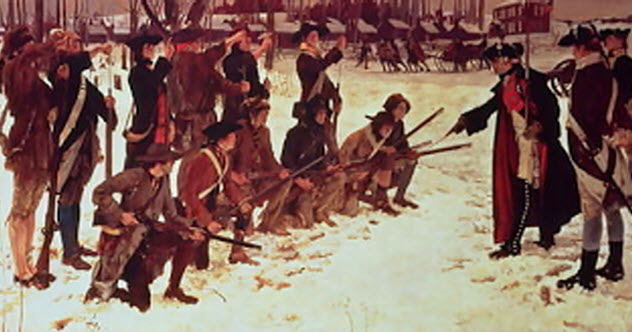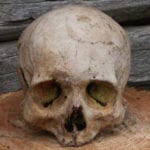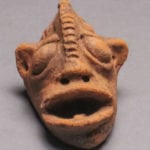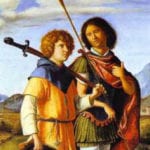 Mysteries
Mysteries  Mysteries
Mysteries  History
History 10 Surprising Stories About the Texas Rangers
 Humans
Humans 10 Philosophers Who Were Driven Mad by Their Own Theories
 Miscellaneous
Miscellaneous 10 Video-Game-Worthy Weapons and Armors from History
 Weird Stuff
Weird Stuff 10 Psychics Who Accurately Predicted Wartime Events
 The Arts
The Arts 10 Pieces of Art Inspired by a Broken Heart
 Health
Health 10 Science Fiction-Sounding New Medical Treatments
 History
History 10 Surprising Facts About the Father of Submarine Warfare
 Space
Space Ten Astonishing New Insights into Alien Worlds
 Weird Stuff
Weird Stuff 10 Bizarre Summer Solstice Rituals Still Practiced Today
 Mysteries
Mysteries Top 10 Haunting Facts About the Ghost Ship MV Alta
 History
History 10 Surprising Stories About the Texas Rangers
 Humans
Humans 10 Philosophers Who Were Driven Mad by Their Own Theories
Who's Behind Listverse?

Jamie Frater
Head Editor
Jamie founded Listverse due to an insatiable desire to share fascinating, obscure, and bizarre facts. He has been a guest speaker on numerous national radio and television stations and is a five time published author.
More About Us Miscellaneous
Miscellaneous 10 Video-Game-Worthy Weapons and Armors from History
 Weird Stuff
Weird Stuff 10 Psychics Who Accurately Predicted Wartime Events
 The Arts
The Arts 10 Pieces of Art Inspired by a Broken Heart
 Health
Health 10 Science Fiction-Sounding New Medical Treatments
 History
History 10 Surprising Facts About the Father of Submarine Warfare
 Space
Space Ten Astonishing New Insights into Alien Worlds
 Weird Stuff
Weird Stuff 10 Bizarre Summer Solstice Rituals Still Practiced Today
10 Fascinating But Forgotten Men From American History
We all know the “great men” of American history. Their faces adorn dollar bills and are chiseled into the sides of mountains. But what about the lesser-known figures like baseball’s first great mascot or the Native American who saved Ulysses S. Grant? Well, since we recently learned about some amazing American women, today we’re focusing on 10 fascinating but forgotten men from American history.
10Don ‘Mr. Wizard’ Herbert
TV’s Original Science Guy
Long before Neil deGrasse Tyson or Bill Nye took to the airwaves, there was Don “Mr. Wizard” Herbert. Back in the 1950s, kids watched TV shows like The Mickey Mouse Club and Adventures of Superman. But Don Herbert’s program was a radical departure from the standard 1950s fare. Titled Watch Mr. Wizard, the show took place in Herbert’s garage, and every week, a young kid would visit Mr. Wizard to learn about matter or electricity and work up some scientific magic.
Mr. Wizard was the first person to combine entertainment and education for TV audiences. Wanting to win over his young viewers, Herbert intentionally did away with the stuffy old lab coat, choosing instead to dress like a regular guy. Instead of using test tubes or intimidating tools, he relied on run-of-the-mill appliances and household items to perform his bizarre scientific experiments.
As Bill Nye described the show to the Los Angeles Times, “Mr. Wizard stood eggs on end, hammered nails with cryogenic bananas, and graphed shrinking gases on their way to absolute zero.” As you can guess, Watch Mr. Wizard was wildly popular.
Thousands of fan clubs popped up across North America, but unfortunately, NBC canceled the show in 1965. Thankfully, Herbert later made a grand comeback on Nickelodeon in 1983. He also appeared on the first episode of The Late Show. After all, David Letterman was a huge fan as a kid.
Herbert also inspired infotainers like Steve Spangler and Bill Nye the Science Guy. Before his death at 89, Herbert won the Council of Elementary Science International’s Science Advocate Award. But more important than any prize was the impact Mr. Wizard had on kids in the US, Mexico, and Canada, influencing thousands of young minds while changing the TV landscape for good.
9Kurt Chew-Een Lee
The First Asian-American Marine Officer
In 1946, Kurt Chew-Een Lee made history by becoming the first Asian-American officer in the Marine Corps. But that’s just scratching the surface of his amazing story.
Born in 1926, Lee joined the Marines in 1944. At first, his job was teaching Japanese, but by the time the Korean War rolled around, he was a first lieutenant leading his own machine gun platoon. Despite his insignia, Lee faced quite a bit of discrimination from his troops, some of whom disparagingly referred to him as a “Chinese laundryman.”
They also worried if he would be willing to kill Chinese soldiers. After all, the Chinese entered the conflict in 1950, siding with North Korea. Would Lee fight for his country or his ancestral homeland?
On November 2, 1950, Lee answered the question with action. During a firefight with the North Koreans, Lee’s platoon was suddenly outnumbered by a fresh batch of Chinese troops. But after the guns fell silent, the Americans weren’t sure where the Chinese soldiers were hiding.
That’s when Lee headed into a no-man’s-land by himself, firing shots and chucking grenades in hopes of exposing the enemy’s position. He even put his Chinese ancestry to good use, confusing the enemy by calling out to them in Mandarin. Lee was wounded during his insane solo mission, but thanks to his bravery, his platoon was able to locate and defeat the enemy troops.
He received the Navy Cross for his actions and was instructed to stay in bed for a while to recuperate. But Lee wasn’t that kind of guy. With his injured arm still in a sling, he “borrowed” an Army jeep and returned to the battlefield. Just weeks later, he led his men through the mountains in a successful attempt to rescue 8,000 Marines who were on the verge of being captured by the Chinese.
Finally, Lee was awarded the Silver Star after his platoon found themselves under heavy enemy fire. While bullets whizzed everywhere, Lee was constantly moving back and forth, helping his men find shelter. Although he was eventually hit by a machine gun blast, he was back in action for Vietnam.
When he finally retired in 1968, he left the Marines as a major. Luckily, the rest of Lee’s life was pretty calm. In March 2014, he passed away at the ripe old age of 88.
8Max Patkin
The Clown Prince Of Baseball
Whether you’re a hater or a fan, we can all agree that baseball tends to get a little slow. That’s when you need a mascot like the San Diego Chicken or the Phillie Phanatic to liven things up. But before these costumed characters appeared on the scene, there was Max Patkin, “The Clown Prince of Baseball.”
During World War II, Max Patkin was a sailor stationed in Hawaii. One day, he found himself pitching in an Army-Navy exhibition game against the legendary Joe DiMaggio. But after Joltin’ Joe knocked one of Patkin’s pitches out of the park, Max followed the famed slugger around the infield, imitating DiMaggio’s distinctive run.
The crowd ate it up, and after the war ended, Patkin was hired to perform for the Cleveland Indians. Over the years, he also entertained fans of the St. Louis Browns and countless minor league teams. In addition to baseball games, he performed with the likes of Groucho Marx, Dick Van Dyke, and the Harlem Globetrotters. He even had a cameo in the Kevin Costner film Bull Durham.
So what made Patkin so popular? Well, he would stand behind players and copy their moves. He would take fake naps on top of the bases or dance to “Rock Around the Clock.” With his hat sideways, he’d goad spectators with insults like “What a crowd! I had more people in my bed last night.”
Near the end of his act, Patkin would step up to the plate, crawl through the catcher’s legs, run around the field, and finally get tossed out by the umpire. Patkin was particularly famous for his geyser routine, an odd act where Patkin drank a glass of water and then proceeded to spray an impressive amount of mist in the air. Sometimes, he would send up 30 blasts after only one glass of water.
After performing over 4,000 times (and missing only one game after his angry wife bashed his head with a hammer), Patkin made his final appearance in Glens Fall, New York, in 1993, six years before he passed away at the age of 79.
7Emory Douglas
The Black Panther Artist
Founded by Huey P. Newton and Bobby Seale, the Black Panthers were dedicated to combating government harassment of African Americans as well as providing for their community. But to stir people up and spark a revolution, they needed a way to spread their message. So in 1967, the Panthers formed their own newspaper.
However, the paper’s true power was in its illustrations of bipedal pigs and heroic black men wielding machine guns. The man behind those images was Emory Douglas, the official artist of the Black Panther Party.
Growing up, Douglas found himself in and out of jail. At 15, he was imprisoned for burglary, and that’s how he wound up working in a prison print shop. He fell in love with graphic design. When he was released, he enrolled in San Francisco City College to study commercial art.
Combining his artistic passions with his politics, Douglas eventually met Black Panther leaders Eldridge Cleaver and Huey Newton and offered to improve their newspaper, explaining that his artwork could send a powerful message to the black community. The Panthers were impressed and appointed Douglas as their Minister of Culture.
Working out of an apartment, Douglas used razor blades and press type to create his collages and provocative posters. As you might expect, it was difficult work, especially since the FBI wouldn’t leave him alone. According to Douglas, the Feds made it incredibly difficult to distribute the paper. On one occasion, he believes the Feds tried to lure him into a trap by having an agent pose as a prospective art buyer.
Despite the dangers, he kept working. According to Douglas, the paper was read by 400,000 people at its peak. In fact, his artwork was often reprinted and posted on city walls and college campuses. Some of his illustrations included Nixon with a swastika on his forehead and a black woman holding an RPG. Douglas is also the guy who popularized the image of the pig to represent government corruption.
Although the paper folded in 1979 (and the Panthers shortly thereafter), Douglas kept on creating art. Until recently, he worked as a graphic artist for San Francisco’s Sun-Reporter.
6William Temple Hornaday
The Man Who Saved The American Bison
Once upon a time, trains traveling across the American prairie were forced to stop for hours as herds of bison rushed across the tracks. But as hunters and settlers migrated west, the American bison started to disappear. In 1886, it was estimated that there were fewer than 300 bison left in the wild. And that’s why William Temple Hornaday decided to shoot a few before it was too late.
However, he wasn’t interested in killing for sport. Born in 1854, Hornaday was the Leonardo da Vinci of taxidermists. He traveled the world hunting exotic creatures and turning them into works of art. Eventually, he became the Smithsonian’s chief taxidermist.
Hornaday believed that taxidermy was a way of preserving animals for future generations. He was especially worried that the bison were going to vanish forever. Since the Smithsonian didn’t have any specimens, he thought he should stuff a few to preserve their memory.
So in 1886, he headed out to Montana on his so-called “Last Buffalo Hunt.” Hornaday described the process as “exceedingly unpleasant,” but after taking 25 trophies, he stuffed the creatures and put them on display for the world. Although Hornaday had good intentions, his outlook radically changed over time. In fact, by the 1900s, he was leading the first captive breeding program.
In 1905, Hornaday and President Theodore Roosevelt created the American Bison Society, an organization that bred captured bison in New York and shipped them west by train, reintroducing them into the wild to increase their numbers. In addition to forming bison ranges in Montana and Kansas, Hornaday fought for crucial conservation laws like the Migratory Bird Act, wrote a best-selling book in defense of all American animals, and founded the National Zoo to preserve endangered species. Without him, it’s possible that the American bison would have become extinct.
However, Hornaday did have a darker side. After becoming director of the Bronx Zoo in 1896, he was the man responsible for displaying a Congolese man named Ota Benga like a wild animal.
5Captain Edward Dwight
The Would-Be Black Astronaut
In 1983, Guion Bluford Jr. became the first African American in space. But history might have been different if President John F. Kennedy hadn’t taken a trip to Dallas. Originally, Kennedy wanted to send a white man, an Asian man, and a black man to the Moon. And he thought Captain Edward Dwight might fill that third spot.
Born in 1933, Dwight grew up near Kansas City, Kansas. He fell in love with airplanes and decided to become an Air Force pilot. Of course, that was going to be difficult. Not only was he black, he was also a little under 163 centimeters (5’4″) tall, the Air Force minimum at the time. But despite the obstacles, Dwight convinced the folks in DC to test potential pilots at his college. He aced the test, wowing military officials and eventually becoming a B-57 pilot.
Many of his commanding officers thought Dwight had a bright future, but everything changed in 1961 when Kennedy invited him to join the space program. Worried that he’d jeopardize his career, many people advised him to turn down the offer. But with his mom’s encouragement, he showed up at Edwards Air Force Base in southern California, ready for the flight of his life.
At first, Dwight was a celebrity who graced the covers of magazines like Ebony and Jet. He received fan mail and parades. But at Edwards, he faced quite a bit of discrimination. His white peers felt the government was “trying to cram [Dwight] down their throats.” Famed instructor Chuck Yeager allegedly ordered the other candidates to give Dwight the cold shoulder, hoping to break his spirit.
Despite the pressure, he never gave up. But after Kennedy’s assassination, Dwight was kicked out of the space program. Even worse, he was appointed the American liaison to the German space program, which didn’t exist at the time. Instead of following orders, Dwight got a jet, flew to DC, and asked the Kennedy brothers for help. Unfortunately, their hands were tied. Frustrated, he left the Air Force in 1966.
Today, Dwight’s a successful artist. Since 1974, he’s created over 100 sculptures of famous African-American figures, from Frederick Douglass to Louis Armstrong to Martin Luther King Jr. Although he never made it to the Moon, he certainly made it big on Earth.
4Sidney Rittenberg
The American Who Worked For Mao
After the US Army sent Sidney Rittenberg to study Chinese at Stanford during World War II, they sent him to Asia to work with the Chinese government. While he loved the country, Rittenberg was disheartened by the rampant corruption, both Chinese and American. Nevertheless, after the war, he remained in China, working for the UN. Once again, he found corruption everywhere he looked . . . except in Mao Tse-tung.
Rittenberg believed that Mao and his communist band were “practicing honest government.” So in 1946, he made his way to Yan’an, Mao’s mountainous headquarters. After arriving at the stronghold, Rittenberg met the future dictator, who asked quite a few questions about America.
Inspired by Mao’s beliefs, Rittenberg became the first American to join the Chinese Communist Party. When Mao’s guerrillas went to war with the nationalists in 1946, Rittenberg helped the communist cause by producing radio propaganda. He even translated for Mao on two occasions, helping him communicate with American officials.
In 1949, the communists took over China. However, believing that Rittenberg was a spy, Russia’s Joseph Stalin pressured Mao to imprison Rittenberg for six years in solitary confinement. “The first year was in total darkness,” Rittenberg said in an interview in The Atlantic. “It was not good.” But when he was freed in 1955 after Stalin’s death, Rittenberg rejoined the revolution.
He immediately returned to the world of broadcasting, translating and sharing propaganda on China Radio International. At first, he was incredibly popular with the Chinese population. But after the rise of the radical Red Guard in 1966, things took a drastic turn. Suspicious of all foreigners, the Red Guard denounced Rittenberg, accusing him of counterrevolutionary activity. Despite the lack of proof, he was tossed into solitary confinement for another 10 years. His Chinese wife was sent to a labor camp.
After Mao died, Rittenberg was released again. Amazingly, he still believed in the chairman’s vision. He finally left China after becoming disgusted with its new leader, Deng Xiaoping. Returning to America, Rittenberg started a firm that helped corporate clients like Microsoft and CBS News to establish businesses in China.
Today, he admits that Mao was a dictator and a criminal. But despite his imprisonment, Rittenberg also believes that Mao was a well-intentioned hero.
3Ely Parker
The Native American General
Ely Parker was quite different from other 19th-century American generals. While most of his peers were white, Parker was a Native American from the Seneca tribe. Born Hasanoanda, Parker changed his name after attending a Christian school as a child. By age 15, he’d mastered the English language and became the official translator for his tribe.
At age 18, he had dinner with President James Polk, and throughout the 1830s and ’40s, he lobbied against white interests that were trying to steal land from the Tonawanda Reservation. But perhaps the most important moment of his young life was when he met former Army officer Ulysses S. Grant. The two men became friends. In the 1860s, Grant became general of the Union Army, eventually appointing Parker as his military secretary.
That was good news for Parker because no one else wanted him involved in the Civil War. But under Grant, Parker saw action at Vicksburg and Chattanooga and even met Abraham Lincoln. On one occasion, Parker realized that Grant was riding straight into Confederate lines and warned the general just minutes before he would have been captured by the rebels.
Perhaps most importantly, Parker drafted the surrender documents signed by Grant and Robert E. Lee at Appomattox. In fact, after Lee signed his name on the paper, he shook Parker’s hand and said, “I’m glad to see one real American here.” Parker replied, “We are all Americans.”
On April 9, 1865, Parker became the Union’s only Native American brigadier general. Four years later, Grant appointed him as the first Native American Commissioner of Indian Affairs. Unfortunately, Parker faced quite a bit of opposition and was charged with fraud after sending food to starving Indians. Although Congress cleared his name, he had grown disgusted with politics and left DC in 1871.
After a brief stint on Wall Street, Parker worked as a clerk for the New York Police Department under Commissioner Teddy Roosevelt. After Parker died in 1895, his body was returned to his people and buried with his ancestors.
2Newton Knight
The Man Who Rebelled Against The Confederacy
In 1861, Mississippi seceded from the Union because the state “thoroughly identified with the institution of slavery.” This posed a problem for Newton Knight, a poor farmer who didn’t own any slaves. He didn’t support slavery, so he wasn’t keen on defending it.
Knight also didn’t like the “Twenty Negro Law,” under which anyone who owned 20 or more slaves could sit out the war. As one of Knight’s friends put it, this was “a rich man’s war and a poor man’s fight.” But Knight could be executed if he didn’t sign up, so he eventually enlisted as an orderly.
Then Confederate soldiers raided his farm and stole his horses. Infuriated, Knight abandoned his regiment and hiked 320 kilometers (200 mi) to his home where he encountered government corruption, rampant poverty, and failing crops. He was arrested in 1863, allegedly tortured, and shipped back to the front lines.
Knight deserted again as soon as he could. Over 100 of his neighbors did the same thing. When they returned to their homes in and around Jones County, they joined with Knight to declare war on the Confederacy.
Under Knight’s command, the “Jones County Scouts” (aka the “Knight Company”) hid in nearby swamps and waged guerrilla warfare on the rebels. Things got incredibly tense in 1863 when Knight allegedly murdered a Confederate major in his bedroom. The following year, Newton supposedly sent General William T. Sherman a declaration of independence claiming that the “Free State of Jones” was officially seceding from the Confederacy.
Angered, Confederate Colonel Robert Lowry and 500 men were sent to crush the Knight Company. Using savage dogs and brutal executions, Lowry tried his best to exterminate the Jones County Scouts. Fortunately, the “Southern Yankees” weathered the storm. When the Civil War ended, the Knight Company was still standing, and the Confederacy was no more.
After the war, Knight was appointed a US marshal, fought the KKK, and headed the effort to distribute food to hungry Mississippians. Later, he scandalized his neighbors by marrying an ex-slave named Rachel, one of his closest wartime allies who’d used a mixture of red pepper and glass to combat Lowry’s attack dogs.
Knight passed away in 1922. But thanks to an upcoming biopic starring Matthew McConaughey, his memory will live on in the 21st century.
1Barnett Davenport
America’s First Known Mass Murderer

America is no stranger to mass killings, but who holds the unenviable title of America’s first known mass murderer? (And to be clear, we’re talking about individual criminals, not acts perpetrated by governments.)
Well, according to historian Michael-John Cavallaro, America’s first known mass murderer was Barnett Davenport, a Revolutionary War soldier who fought under George Washington and Benedict Arnold. But while he served at Valley Forge, Davenport wasn’t a hero. Not only was he a two-time deserter, he was a convicted robber and horse thief.
Davenport was also obsessed with murder. After his second desertion in 1780, the 20-year-old got a job working for Caleb Mallory, a Connecticut farmer who operated a grist mill. Caleb lived with his wife, daughter, and three grandchildren. After hiring Davenport, there was a new member in the Mallory household.
But on February 3, Davenport crept into Caleb’s bedroom and beat the elderly man, his wife, and their eight-year-old granddaughter to death with a swingle, a rifle, and a pestle. After searching the room for valuables, Davenport set the house on fire, burning Caleb’s six- and four-year-old grandsons to death. Their mother was spared because Davenport had convinced her to take a vacation shortly before the murders, probably to get her out of the way.
As the newspapers put it, these were “the most horrid murders ever perpetrated in this country, or perhaps any other.” In his confession, Davenport called it a “night big with uncommon horror.” Of course, he only confessed after authorities found him lurking in a nearby cave six days later.
Authorities also arrested his brother, Nicholas. At first, it was a case of mistaken identity. When Barnett had arrived at the Mallory mill, he’d given his name as “Nicholas” to cover his tracks. But even after he explained the mix-up, the police thought Nicholas was an accomplice. Nicholas was sentenced to 40 lashes and life in prison. Barnett also received 40 lashes and was executed in May 1780.
Nicholas was released after two years, although his punishment wasn’t over. Since he hadn’t contacted the authorities when he knew his brother had deserted, Nicholas was ordered to remain in the town of New Milford, Connecticut, for the rest of his life. That’s where he stayed until his death at age 58.
Nolan Moore is a freelance writer from Texas. If you want, you can friend/follow him on Facebook or email him here.








